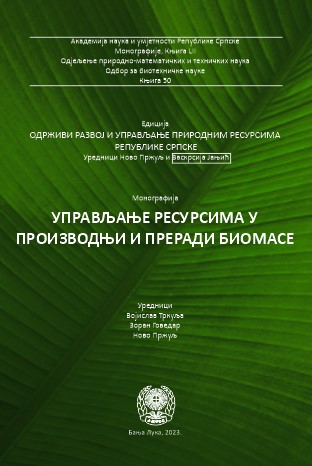Production of biomass from forests and residues from the wood processing industry
DOI:
https://doi.org/10.7251/EORU2306249GKeywords:
Forest, wood processing industry, biomass, energy, Republic of SrpskaAbstract
An analysis of the relationship between technological and social development in the history of mankind shows that changes have always been related to the use of energy. Limited opportunities and negative environmental effects of the use of fossil fuels are increasingly affecting the need to use renewable energy sources. Today, more and more attention is paid to reducing the negative effects of energy on the environment, and the importance of renewable energy sources from forests is emphasized. Biomass is living matter whose reserves are constantly replenished by the action of solar energy. Wood biomass is a renewable energy source that includes wood mass from the forest, secondary (non-commercial) wood mass, wood residues and used wood. From the energy aspect, forest biomass includes woody vegetation and its remains suitable for energy production. Of particular importance, especially in countries with significant forest resources, is forest biomass as a renewable energy source. Although there are objective limitations that make it difficult to use forest biomass for energy, it does they do not represent permanent obstacles but imply their gradual, systematic and long-term elimination. It is assumed that the problems of lack of energy in the near future will be among the first challenges of modern society. Therefore, it is necessary to harmonize the production of biomass (breeding forestry) with previously developed nursery production (quantity, quality and type of planting material), natural regeneration and forest care (forest management systems) with the capacities and possibilities for using forest biomass for energy. Intensifying the use of forest biomass implies the introduction of modern technological solutions and machines (harvesters, forwarders, etc.) for which there are no adequate human resources for handling these machines, and the road network is unsatisfactory for their intensive application. Significant amounts of biomass (especially firewood) are traditionally used in numerous households throughout the Republic of Srpska, so it is necessary to examine the efficiency and alternatives of this type of biomass use. The use of forest biomass for energy must be based on sustainability, decentralized access and environmental protection, ie it must take into account the emission of harmful gases, the impact on biodiversity and the level of disruption of natural processes that can endanger life. To that end, specializedenergy plantations are being developed in Europe, in which various types of trees are grown, and the highest yields are achieved with poplars and willows on which significant genetic interventions have been performed. Breeding of species that make up energy crops is rare, although some varieties of species of the genus Salix (willow) are intensively used for biomass production with a harvest cycle every 2–5 years, and are genetically bred to increase their resistance to phytopathological diseases that have a negative impact on biomass yield. Strategic guidelines for the use of forest biomass for energy purposes are related to the promotion of the use of forest biomass for energy purposes in a way that does not endanger the environment.
